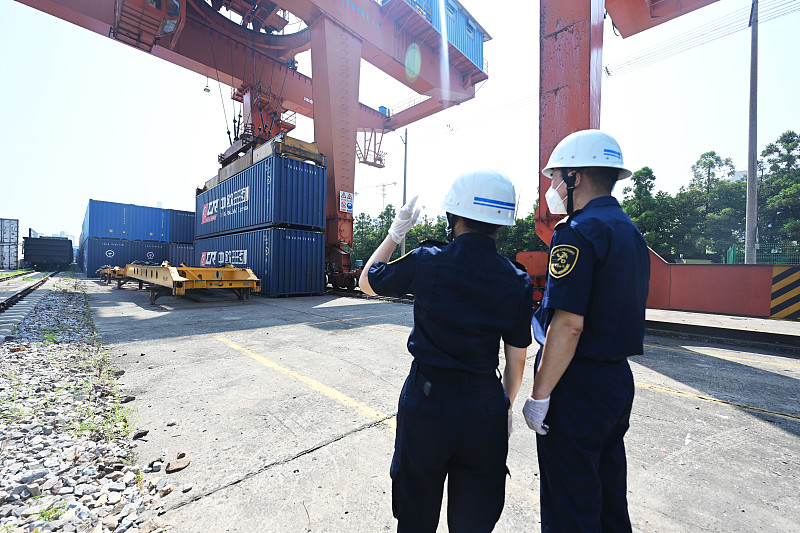
The fourth consultative meeting of the heads of states of Central Asia is held in Cholpon-Ata, Kyrgyzstan, July 21, 2022. /CFP
The fourth consultative meeting of the heads of states of Central Asia is held in Cholpon-Ata, Kyrgyzstan, July 21, 2022. /CFP
Editor's note: Djoomart Otorbaev is the former prime minister of the Kyrgyz Republic, a distinguished professor of the Belt and Road School of Beijing Normal University, and a member of the Nizami Ganjavi International Center. The article reflects the author's views and not necessarily those of CGTN.
The previous piece discussed alternatives to the northern route of the Eurasian railway bridge connecting China and Europe, taking into account the potential suspension of operations due to anti-Russian sanctions. One such alternative could be its southern route connecting China, Central Asia, the South Caucasus, Turkey and Europe. In the past few weeks, both political and economic support for this project has greatly intensified.
Full support for the development of that route through Kyrgyzstan, Uzbekistan, Kazakhstan and Turkmenistan was received during the fourth consultative meeting of the heads of Central Asian states, held on July 21 this year in Cholpon-Ata, Kyrgyzstan. All five presidents stressed that the unique geographic location of Central Asia at the junction of Russia, China, South Asia and Europe enhances the role of the region in promoting transcontinental trade through the southern route.
The China-Kyrgyzstan-Uzbekistan railway project was actively discussed during the visit of Chinese Foreign Minister Wang Yi to Central Asia at the end of July. At the minister's meetings with the heads of states, it was emphasized that the new railway project would not only facilitate China's trade with Central Asia but would also shorten the distance to Europe. A press release from China's National Development and Reform Commission (NDRC) states that on August 2, Chinese specialists arrived in the Kyrgyz Republic and began work on developing a feasibility study for this railway. The NDRC report also says that thanks to the joint efforts of the three countries, the China-Kyrgyzstan-Uzbekistan railway project has made positive progress.
On August 18, Chinese Premier Li Keqiang sent a message to the government of the Kyrgyz Republic where he mentioned that the development of a feasibility study for the China-Kyrgyzstan-Uzbekistan railway construction project has begun and China is ready to cooperate with the Kyrgyz and Uzbek sides to its further advancement.

A China-Europe freight train bound from Shanghai to Central Asia, July 28, 2022. /CFP
A China-Europe freight train bound from Shanghai to Central Asia, July 28, 2022. /CFP
It is planned that the total length of the new railway will be 523 kilometers with 213 kilometers in China, 260 kilometers in Kyrgyzstan and 50 kilometers in Uzbekistan. The distance between China and Europe will be shortened by 900 kilometers and save up to eight days of travel time compared to the northern route. The railway will complete the southern passage of the global Eurasian railway route, shaping a convenient transport path from East and Southeast Asia to Central, South and Western Asia, the Middle East, Northern Africa and Europe.
If everything goes according to plan, construction of the railway will begin as early as 2023. This was stated on June 8 by the President of Kyrgyzstan Sadyr Japarov during a meeting with residents of the Jalal-Abad region. The president said: "This road will be completed in three to four years if the three countries work together. Kyrgyzstan's income from the project will be at least $200 million."
In addition to political support, specific financial proposals also appeared. The European Bank for Reconstruction and Development on July 25 announced its intention to invest up to $100 million in bonds of Kazakhstan Railways JSC. According to the text of the information message, these investments are intended to develop the Trans-Caspian international transport route.
In the same week, the allocation of $30.8 billion for the development of railway infrastructure by 2030 was announced by the Russian government. With these funds, three railway checkpoints will be established on the Russian borders and a new 369 kilometers of railway track in Russia and 3,000 kilometers in Kazakhstan, Mongolia and China will be built. The largest of these projects may involve the creation of a transport corridor Russia-Mongolia-China.
In all likelihood, intensive preparations are underway for the upcoming Shanghai Cooperation Organization (SCO) summit in Samarkand, Uzbekistan, in September. Both officials and observers are counting on the fact that during the SCO summit, the heads of state will sign agreements on the construction of the railway, perhaps even in a face-to-face format. The current SCO Secretary-General Zhang Ming, a veteran Chinese diplomat, told reporters on July 15 the grouping hopes for an in-person summit in Uzbekistan.
Judging by the nature and intensity of the negotiation process between the parties involved, the upcoming SCO summit in Samarkand can make truly historical decisions on the Asian countries' connectivity. Critics of the southbound railway bridge have always pointed to the need to cross multiple borders as a major drawback. But this "flaw" can be reformatted into a virtue, building an atmosphere of trust and multifaceted cooperation between the countries involved in the project. Not only China and Europe will become closer to each other, but also all countries involved in such a belt of friendship. The emergence of a new great Silk Road is quite possible.
(If you want to contribute and have specific expertise, please contact us at opinions@cgtn.com. Follow @thouse_opinions on Twitter to discover the latest commentaries in the CGTN Opinion Section.)

